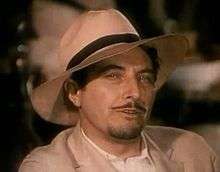Roy D'Arcy
| Roy D'Arcy | |
|---|---|
 Roy D'Arcy in Captain Calamity (1936) | |
| Born |
Roy Francis Giusti February 10, 1894 San Francisco, California, U.S. |
| Died |
November 15, 1969 (aged 75) Redlands, California |
| Occupation | Actor |
| Years active | 1925–1939 |
Roy D'Arcy (February 10, 1894 – November 15, 1969) was an American film actor of the silent film and early sound period of the 1930s noted for his portrayal of flamboyant villains. He appeared in 50 different films between 1925 and 1939, such as The Temptress in 1926 with actresses such as Greta Garbo.
Biography
Roy D'Arcy was born as Roy Francis Giusti in San Francisco but educated in Europe and studied painting in Paris. After several years of traveling and various business ventures in South America and Asia he returned to the United States and decided to become involved in the theater. He was hired as a singer in several touring theatrical companies. In the early 1920s, he spent some time in vaudeville.[1]
D'Arcy was performing his show on a Los Angeles stage when he was spotted by director Erich von Stroheim, who thought D'Arcy was just right for the part of the villainous, arrogant Prince Mirko in The Merry Widow. Von Stroheim had wanted to play the part himself, but was forbidden from doing so by MGM production head Irving Thalberg.[2] It was a troubled production - from which von Stroheim was fired, brought back, then fired again - but the film was a great critical and financial success.[2]
With the success of film he was cast in several other MGM productions as the head villain, such as Beverly of Graustark (1925), La Bohème (1926) and The Temptress (1926) alongside Greta Garbo, but he soon appeared in such comedies as Adam and Evil (1927), Frisco Sally Levy (1927) and On Ze Boulevard (1927). He developed a revue he took to Broadway in 1928, called "The Greatest Array of Talent Ever Assembled on Any Bill in This Country", which consisted of singers, dancers, and D'Arcy himself walking out into the audience and telling stories of his travels around the world.
D'Arcy made the transition from silent film very well, and played a succession of foreigners, both villainous and otherwise, in films of the early 1930s. However, as acting styles changed because of the introduction of sound, D'Arcy's unique florid style went out of fashion, and in a few years he was reduced to doing small, low-budget pictures for lower independent studios, such as Broadway to Cheyenne (1932) for Monogram Pictures and Discarded Lovers (1932) for Tower Pictures. He did though have noted roles in a serial for Mascot Pictures Corporation, The Shadow of the Eagle (1932), starring a young John Wayne, and in his second serial, The Whispering Shadow (1933) with Bela Lugosi.[3]
By the mid-1930s D'Arcy continued playing villainous roles in a number of low-budget productions including Revolt of the Zombies (1936), Captain Calamity (1936) and Under Strange Flags (1937).[4] His final film was to be a major one, in the Ginger Rogers/Fred Astaire musical The Story of Vernon and Irene Castle in 1939 which received widespread acclaim.
Finishing his film career around the age of 45, D'Arcy retired to his own real estate business. He died in 1969 and was buried at Montecito Memorial Park in Colton, California.[5]
Selected filmography
- Orient Express (1934)
References
- ↑ "Roy D'Arcy". The New York Times. Retrieved 22 August 2014.
- 1 2 "The Merry Widow". Silentfilm.org. Retrieved 22 August 2014.
- ↑ Lennig, Arthur (18 July 2013). The Immortal Count: The Life and Films of Bela Lugosi. University Press of Kentucky. p. 188. ISBN 0-8131-4376-4.
- ↑ Liebman, Roy (1998). From Silents to Sound: A Biographical Encyclopedia of Performers who Made the Transition to Talking Pictures. McFarland. p. 83. ISBN 978-0-7864-0382-0.
- ↑ Roy D'Arcy at Find a Grave
External links
| Wikimedia Commons has media related to Roy D'Arcy. |
- Roy D'Arcy at the Internet Movie Database
- Roy D'Arcy at the Internet Broadway Database

- Roy D'Arcy at Virtual History